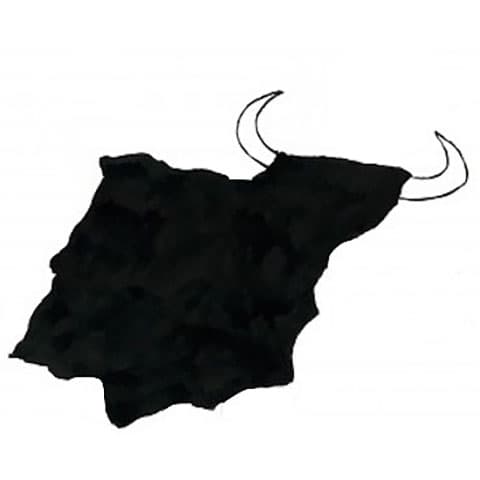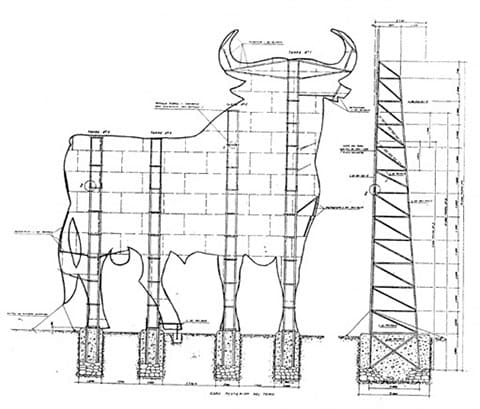
Figure 1
It was probably the “Toro de Osborne” that shaped the image of Spain as a bull. “Osborne” (“os-bor-ne” in the Spanish reading) is the name of an old winemaking firm established in 1772 in El Puerto de Santa María, a port town on the Atlantic coast in the Province of Cádiz, at the southernmost edge of the Autonomous Community of Andalusia, in Spain’s south.
The bull is also the character used in some of the sales promotion campaigns for Veterano, a brandy aimed at the Spanish market by Osborne, which was chiefly a sherry maker and supplier to England in the beginning and later became a purveyor to royal households across Europe. Then in 1957 it started setting up large roadside billboards with the black silhouette of a bull. Photo 1 shows one of the early bull billboards. At first, they were made of wood, and the bull’s horns were painted white. At their most prolific, there were an amazing 500 or so billboards all across Spain.

Photo 1
But then along with an increase in car accidents, regulations tightened up and the authorities issued a bylaw forbidding the erection of roadside billboards that might distract drivers. They moved the billboards away from roadsides, but gradually built them bigger and also more robust, so that they could be seen from a distance, which eventually led to the birth of a giant bull weighing 5,000 kg made of 70 steel sheets fixed with 1,000 bolts, supported by 4 steel pillars, and 14 meters in each direction. Figure 2 is a drawing of one of those bull billboards.

Figure 2
Then the authorities tightened the regulations even further, prohibiting all billboards visible from the road, which threatened the existence of these bulls. But supporters started up a campaign to protect the bull billboards, on the basis that the bull was already an icon standing for Spain. In the end, the authorities decided that the billboards were a part of the Spanish landscape and were cultural heritage, so the bulls were saved on condition that any promotional text be blacked out and only the silhouette be kept. If you take a look at photo 2, I think you might see just how this bull blends into the Spanish landscape.

Photo 2
There are currently 95 of these billboards in Spain, 6 in Mexico, 1 in Denmark, and amazingly, 1 in Japan. The one in Mexico is still used for advertising with the bull’s torso featuring the word “Magno,” a sherry brandy from the Osborne winery. Photo 3 shows the billboard in Mexico. Below the product name and company name in small letters are the words “...Drink in moderation.”

Photo 3
The one in Denmark was erected in Copenhagen as a symbol of Spain, in Superkilen Park, whose purpose is exchange among a wide variety of countries, not as an advertisement. Two elderly women who live near the park managed to get the billboard erected after putting the proposal to the local city authorities and Osborne because “the happiest memories of our 80-something-year-long lives are from the fun times we spent in Spain on vacation, and it was this bull that greeted us every time we went there.” Photo 4 shows the Osborne bull living in Denmark alongside a donut billboard representing the USA.

Photo 4
The bull in Japan is not an advertising billboard either. It is a work of art put on display for an arts festival held in 2018 in the Echigo Tsumari region of Niigata Prefecture. As the advertising manager at Osborne says, “We took into account the earthquakes and heavy snow when we put it up, so it is the most sturdily built bull of all.” Photo 5 shows the Osborne bull looking out over Matsunoyama hot spa resort. The name of the work is “Black Symbol.”

Photo 5
To be continued...






























































